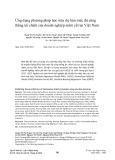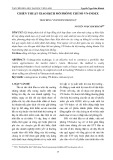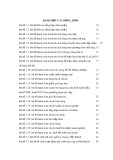
9
© Học viện Ngân hàng
ISSN 3030 - 4199
Tạp chí Kinh tế - Luật & Ngân hàng
Số 264- Năm thứ 26 (5)- Tháng 5. 2024
So sánh tính đáng tin cậy của các ước tính giá trị nội tại
tạo ra từ ba mô hình định giá dòng tiền và mô hình bội số
Lê Hồ Anh Thư1, Nguyễn Thị Hoài Thu2
1Bộ Tài chính, Việt Nam, 2Học viện Ngân hàng, Việt Nam
Ngày nhận: 26/03/2024 Ngày nhận bản sửa: 25/04/2024 Ngày duyệt đăng: 10/05/2024
Tóm tắt: Các mô hình định giá trên lý thuyết cho ra những kết quả ước tính giá
trị cổ phiếu giống nhau với điều kiện những giả định được triển khai một cách
nhất quán. Trong thực tế, các nhà phân tích hiếm khi có được kết quả bằng nhau
từ các mô hình này. Các nghiên cứu trước đây chưa từng so sánh sự khác biệt
giữa các mô hình dòng tiền và bội số. Nghiên cứu này đóng góp vào tổng quan
nghiên cứu bằng việc so sánh độ chính xác và đáng tin cậy của ba mô hình định
giá dòng tiền, bao gồm mô hình chiết khấu cổ tức (DDM), mô hình chiết khấu
dòng tiền (DCF), mô hình thu nhập thặng dư (RIVM) với mô hình định giá bội số
(PE1). Các mô hình được so sánh trên ba tiêu chí: độ thiên lệch (bias), độ chính
xác (accuracy) và khả năng giải thích (explainability) bằng cách sử dụng kiểm
Comparing the reliability of the intrinsic value estimates derived from three flows-based
models and a multiples-based model
Abstract: Different equity valuation models in theory provide identical estimates of equity intrinsic values if they
are implemented with consistent assumptions. In practice, it is not unusual to obtain different value estimates
from different models. Prior research on the comparison between multiples-based valuation model and flows-
based valuation models are quite limited. This research contributes to the literature by comparing the accuracy
and reliability of three flows-based valuation models (discount dividend model, discounted free cash flow model,
residual income valuation model) and multiples-based valuation model using one-year forward forecasted
earning (PE1). For the analysis, all models are tested for bias, accuracy and explainability using t-tests, Wilcoxon
tests and OLS regressions with a large sample of 40.547 observations from U.S public firms during the period
from 2010 to 2020. Results show that PE1 value estimates are more accurate and reliable than that of flows-based
models; and among flows-based models, residual income valuation model performs best. This research provides
evidence for the performance and usage of such models to support sell-side equity analysts while making
decisions of which model to use.
Keywords: Equity valuation, Equity valuation models, Equity intrinsic value, Value estimates
Doi: 10.59276/JELB.2024.05.2698
Le, Ho Anh Thu1, Nguyen, Thi Hoai Thu2
Email: lehoanhthu@mof.gov.vn1, hoaithu@hvnh.edu.vn2
Organization: Ministry of Finance (MoF), Vietnam1, Banking Academy of Vietnam2

So sánh tính đáng tin cậy của các ước tính giá trị nội tại tạo ra từ ba mô hình định giá
dòng tiền và mô hình bội số
10 Tạp chí Kinh tế - Luật & Ngân hàng- Số 264- Năm thứ 26 (5)- Tháng 5. 2024
định t-test, Wilcoxon và mô hình hồi quy tuyến tính trên mẫu lớn với 40.547
quan sát từ các công ty đại chúng tại Mỹ trong giai đoạn 2010- 2020. Kết quả
cho thấy PE1 vượt trội hơn các mô hình dòng tiền về độ chính xác và đáng tin
cậy. Trong số các mô hình dòng tiền, RIVM cho kết quả tốt nhất. Những kết quả
này góp phần minh chứng hiệu suất và hiệu quả của các mô hình định giá, qua
đó hỗ trợ cho nhà phân tích nghiên cứu đưa ra quyết định về việc lựa chọn mô
hình để sử dụng trong quá trình định giá doanh nghiệp.
Từ khoá: Định giá doanh nghiệp, Mô hình định giá, Giá trị nội tại, Giá trị ước tính
1. Giới thiệu
Định giá vốn chủ sở hữu (equity valuation)
sử dụng số liệu kế toán, liên quan đến việc
biến đổi các ước tính biến số kế toán thành
một ước tính giá trị cổ phiếu, là một trong
những trọng tâm trong nghiên cứu tài chính
và kế toán (Palepu và Healy, 2013). Các
nhà đầu tư, phân tích, quản lý quỹ sử dụng
nhiều mô hình định giá khác để hỗ trợ họ
đưa ra quyết định tài chính như lựa chọn
danh mục đầu tư hoặc định giá thương vụ
mua bán sáp nhập. Trên lý thuyết, các mô
hình này cho ra những ước tính giá trị cổ
phiếu (value estimates) giống nhau, nếu
được triển khai với các giả định nhất quán
(Penman và Sougiannis, 1998; Francis và
cộng sự, 2000); trong thực tế, không hiếm
khi nhận được kết quả khác nhau từ các mô
hình này (Lundholm và O’keefe, 2001).
Do đó, việc xác định độ chính xác của các
mô hình trong định giá doanh nghiệp trở
nên cần thiết để có được những ước tính
giá trị đáng tin cậy hơn. Bài báo này kiểm
chứng liệu độ tin cậy của các ước lượng
giá trị của các mô hình định giá bao gồm
mô hình bội số (Multiples-based valuation
model- MBVM), các mô hình định giá
dựa vào dòng tiền (Flows-based valuation
models- FBVM) như mô hình chiết khấu
cổ tức (Dividend discount model- DDM),
mô hình dòng tiền chiết khấu (Discounted
cash flows model- DCF) và mô hình thu
nhập thặng dư (Residual income valuation
model- RIVM) có khác biệt hay không.
Penman & Sougiannis (1998) (gọi tắt là PS)
so sánh độ thiên lệch (bias) và độ chính xác
(accuracy) của DDM, DCF và RIVM bằng
cách sử dụng cách tiếp cận nhìn xa thấy
trước (foresight) và phát hiện ra sai số định
giá của DCF trong khoảng 10 năm lớn hơn
so với RIVM. Francis và cộng sự (2000)
bổ sung nghiên cứu của PS bằng cách thêm
vào khả năng giải thích được đo bằng R2
trong các mô hình hồi quy làm chỉ số hiệu
suất của các ước tính giá trị. Nhìn chung,
các nghiên cứu so sánh độ chính xác của
các mô hình kết luận rằng RIVM vượt trội
so với DCF và DDM trong việc ước tính cổ
phiếu (Lundholm và O’keefe, 2001). Một
hướng nghiên cứu khác của chủ đề này là
so sánh hiệu suất của các động lực giá trị
(value drivers) trong MBVM (Liu và cộng
sự, 2002; Liu và cộng sự, 2007). Tuy nhiên,
nghiên cứu so sánh giữa MBVM và FBVM
khá hạn chế. Do đó, bài báo này đóng góp
vào tổng quan lý thuyết bằng cách lấp đầy
khoảng trống nghiên cứu này.
Nghiên cứu này đề xuất hai giả thuyết. Giả
thuyết thứ nhất, trái ngược với các nghiên
cứu trước, cho rằng MBVM vượt trội so với
FBVM, và giả thuyết thứ hai, nhất quán với
Francis và cộng sự (2000), cho rằng RIVM
vượt trội hơn so với FBVM. Cả hai giả
thuyết được kiểm tra căn cứ ba chỉ số là độ
thiên lệch (bias), độ chính xác (accuracy)

LÊ HỒ ANH THƯ - NGUYỄN THỊ HOÀI THU
11
Số 264- Năm thứ 26 (5)- Tháng 5. 2024- Tạp chí Kinh tế - Luật & Ngân hàng
và khả năng giải thích (explainability)
bằng cách sử dụng các kiểm định t-test,
Wilcoxon và mô hình hồi quy OLS trên
một mẫu lớn các công ty niêm yết tại Mỹ từ
năm 2010 đến 2020. Kết quả cho thấy rằng
MBVM sử dụng dự báo lợi nhuận một năm
tiếp theo tốt hơn các FBVM ở tất cả các chỉ
số; RIVM cho ra ước tính giá trị chính xác
nhất trong số các FBVM. Tương tự Francis
và cộng sự (2000), bài báo này cũng kiểm
tra tác động của mức chi phí Nghiên cứu và
Phát triển (R&D) đối với độ tin cậy của giá
trị ước tính.
2. Cơ sở lý thuyết và giả thuyết nghiên cứu
2.1. Các mô hình định giá
Mô hình chiết khấu cổ tức (DDM), xây
dựng bởi John Burr Williams (1938), giả
định rằng giá trị nội tại của vốn doanh
nghiệp là tổng của các khoản thanh toán
dự kiến cho cổ đông đã được chiết khấu
(Francis và cộng sự, 2000).
VT
DDM = (Et[DIVt + 1])(1 + re)-1 + (Et[DIVt + 2])
(1 + re)-2 + (Et[DIVt + 3])(1 + re)-3 + ... [2.1]
Trong đó:
VT
DDM = Giá trị vốn hoá thị trường tại thời
điểm T;
T = Ngày định giá;
Et[DIVt + 1] = Khoản thanh toán cổ tức dự
kiến trong giai đoạn t + 1;
re = Tỷ lệ chi phí vốn.
Nghiên cứu này sử dụng mô hình chiết khấu
cổ tức hai giai đoạn, bao gồm giai đoạn
tăng trưởng cao và giai đoạn tăng trưởng
ổn định với một tỷ lệ tăng trưởng không đổi
được duy trì vĩnh viễn sau đó. Mô hình này
cho phép ngừng dự đoán cổ tức hàng năm
và bắt đầu ước lượng giá trị mà chúng tôi
cho rằng công ty sẽ đạt được vào cuối giai
đoạn tăng trưởng cao. Để đơn giản hoá, giả
định rằng giai đoạn tăng trưởng cao chỉ kéo
dài trong hai năm và sau hai năm, cổ tức sẽ
tăng với một tỷ lệ tăng trưởng không đổi
vĩnh viễn :
Vt
e = (Et[DIVt + 1])(1 + re)-1 + (Et[DIVt + 2])(1
+ re)-2 + {(Et[DIVt + 2])(1+g))(re - g)-1)}(1 +
re)-2 [2.2]
Mô hình chiết khấu dòng tiền tự do (DCF)
thay thế cổ tức bằng dòng tiền tự do, dựa
trên giả định rằng dòng tiền tự do là đại
diện tốt hơn cho các giá trị tăng thêm trong
một khoảng thời gian ngắn (Francis và
cộng sự, 2000). Dòng tiền tự do là dòng
tiền có thể được phân phối cho cổ đông và
chủ nợ sau khi chi trả cho những khoản
đầu tư cần thiết. Nghiên cứu này sử dụng
mô hình dòng tiền thuần của chủ sở hữu
(FCFE) (Damodaran, 2014) với giả định
giai đoạn tăng trưởng nhanh kéo dài 2 năm:
FCFEt = NI
t + Dept ₋ ∆WCt ₋ Capext +
∆BVDt [2.3]
Vt
e = (Et[FCFEt + 1])(1 + re)-1 + (Et[FCFEt + 2])
(1 + re)-2 + {(Et[FCFEt + 2])(1+g))(re - g)-1)}(1
+ re)-2 [2.4]
Trong đó:
FCFEt = Dòng tiền thuần vốn chủ sở hữu
trong năm t;
NIt = Lợi nhuận thuần năm t;
Dept = Chi phí khấu hao năm t;
∆WC = Sự thay đổi trong vốn lưu động
trong năm t;
Capext = Chi phí đầu tư cố định trong năm t;
∆BVDt = Sự thay đổi trong giá trị nợ sổ
sách trong năm t;
g = Tỷ lệ tăng trưởng cố định của cổ tức
Mô hình thu nhập thặng dư (RIVM) đã
xuất hiện từ vài thập kỉ trước (Preinreich,
1938; Edwards và Bell, 1961; Peasnell,
1982) nhưng ít được giới học thuật chú ý
cho đến nghiên cứu của Ohlson (1995) và
Ohlson & Feltham (1995). RIVM dựa trên
một giả định duy nhất rằng giá cổ phiếu
của công ty bằng giá trị hiện tại của các
cổ tức dự kiến trong tương lai (Lo & Lys,
2000), cũng là giả định của DDM thể hiện
trong phương trình [2.1]. Để rút ra phương

So sánh tính đáng tin cậy của các ước tính giá trị nội tại tạo ra từ ba mô hình định giá
dòng tiền và mô hình bội số
12 Tạp chí Kinh tế - Luật & Ngân hàng- Số 264- Năm thứ 26 (5)- Tháng 5. 2024
trình của RIVM từ DDM, dữ liệu kế toán
và cổ tức phải thoả mãn mối quan hệ thặng
dư sạch (clean surplus relation– CSR), yêu
cầu tất cả lãi và lỗ ảnh hưởng đến giá trị
sổ sách đều được bao gồm trong lợi nhuận
(Ohlsons, 1995):
BVEt₋1 = BVEt ₋ NIt + DIVt [2.5]
DIVt = NIt ₋ (BVEt ₋ BVEt-1) [2.6]
Trong đó:
DIVt = Cổ tức được trả trong năm t;
BVEt = Giá trị sổ sách kế toán của vốn chủ
sở hữu trong năm t;
BVEt₋1 = Giá trị sổ sách kế toán của vốn
chủ sở hữu vào đầu kỳ;
NIt = Lợi nhuận trong giai đoạn kết thúc
vào ngày t.
Khái niệm “lợi nhuận bất thường” (abnormal
earnings) được định nghĩa là lợi nhuận
hiện tại trừ đi lợi nhuận yêu cầu (required
earnings) hoặc lợi nhuận “bình thường”. Lợi
nhuận yêu cầu liên quan đến lợi nhuận bình
thường trên vốn đã đầu tư vào đầu kì, bằng
với chi phí vốn nhân với giá trị sổ sách ròng
vào ngày (Ohlson, 1995).
RIt
e = NIt ₋ (re × BVEt-1) [2.7]
NIt = RIt
e + (re × BVEt-1) [2.8]
Trong đó:
RIt
e = Lợi nhuận thặng dư dự kiến
re = Tỷ lệ chi phí vốn
Thay NI trong RI với NI trong CSR:
DIVt = RIt
e + (re × BVEt-1) ₋ (BVEt ₋ BVEt-1)
[2.9]
DIVt = RIt
e ₋ BVEt + (1 + re)×BVEt-1
[2.10]
CSR ngụ ý rằng tất cả các thay đổi trong
giá trị vốn chủ sở hữu, ngoài giao dịch với
chủ sở hữu như trả cổ tức hoặc phát hành
cổ phiếu, đều thông qua bảng kết quả kinh
doanh (Myers, 1999). Nếu CSR tồn tại,
chúng ta có thể biểu diễn giá trị thị trường
của vốn chủ sở hữu dựa trên lợi nhuận dự
kiến trong tương lai và giá trị sổ sách thay
vì chuỗi cổ tức dự kiến trong công thức
DDM (Ohlson, 1995). Sử dụng biểu thức
này để thay thế trong công thức [2.1] sẽ
dẫn đến phương trình của RIVM:
Vt
e = BVEt + (EtRIe
t + 1)(1 + re)-1 + (EtRIe
t + 1)
(1 + re)-2 + (EtRIe
t + 1)(1 + re)-3 + ...
[2.11]
Vt
e = BVEt + ∑{τ = 1}^{∞}(EtRIe
t + τ)(1 + re)-τ
[2.12]
Giả sử thu nhập thặng dư sẽ tăng với một tỷ
lệ cố định và giai đoạn dự báo 2 năm, đồng
thời thoả mãn điều kiện tỷ lệ lợi tức yêu
cầu phải lớn hơn tỷ lệ tăng trưởng:
Vt
e = BVEt + ∑{τ = 1}^{T}(EtRIe
t + τ)(1 +
re)-τ∑{τ = T + 1}^{∞}(EtRIe
t + τ)(1 + re)-τ
[2.13]
Vt
e = BVEt + (EtRIt + 1)(1 + re)-1 + (EtRIt + 2)
(1 + re)-2 + {((EtRIt + 2)(1+g))(re - g)-1)}(1 +
re)-2 [2.14]
Với giả định CSR tồn tại và thoả mãn điều
kiện của tỷ lệ tăng trưởng như trên, RIVM,
DDM và DCF trên lý thuyết sẽ cho ra cùng
một kết quả giá trị nội tại của công ty. Các
nghiên cứu trong lĩnh vực định giá cổ phiếu
chủ yếu tập trung vào DCF và RIVM, tuy
nhiên sự nhạy cảm của các mô hình này với
các giả định khiến các nhà phân tích khó sử
dụng. Thay vào đó, họ thường sử dụng mô
hình hệ số nhân (MBVM), ví dụ như hệ số
P/E để định giá công ty bởi sự đơn giản của
nó (Lie & Lie, 2002). Phương trình tổng
quát của mô hình bội số như sau:
Vi = VDi × Benchmark Multiplei(φi) [2.15]
Benchmark Multiplei = Pj(VDj)-1 [2.16]
Trong đó:
Vi = Giá trị ước tính của công ty i;
VDi = Động lực giá trị của công ty i, trong
đó VD > 0;
φi = Bộ n công ty so sánh (comparable
firms) cho công ty i, loại trừ công ty i;
Pj = Giá của công ty so sánh thứ j với j =
1 đến n;
VDj = Động lực giá trị của công ty so sánh
thứ j với j = 1 đến n.
2.2. Giả thuyết nghiên cứu

LÊ HỒ ANH THƯ - NGUYỄN THỊ HOÀI THU
13
Số 264- Năm thứ 26 (5)- Tháng 5. 2024- Tạp chí Kinh tế - Luật & Ngân hàng
Các nghiên cứu thực nghiệm so sánh tính
chính xác của các mô hình định giá dựa trên
dòng tiền trong việc ước lượng giá cổ phiếu
phần lớn kết luận rằng RIVM vượt trội hơn
so với DDM và DCF (xem Bernard, 1995;
Penman & Sougiannis, 1998; Courteau &
cộng sự, 2000; Francis & cộng sự, 2000).
Kết quả của Penman & Sougiannis (1998)
cho thấy khi sử dụng các dồn tích kế toán
(accounting accruals) dựa vào GAAP trong
mô hình RIVM đã đưa dòng tiền về phía
trước, do đó bắt được thông tin liên quan
không hiện diện trong dòng tiền và cổ tức
theo tinh thần của Dechow (1994). Trái với
một quan điểm phổ biến rằng dồn tích kế
toán dễ bị bóp méo và gây nên việc quản
trị lợi nhuận (earnings management), từ
đó tạo ra những kết quả không đáng tin
cậy, Francis và cộng sự (2000) khẳng định
tính chuẩn mạnh (robustness) của sự ưu
việt của lợi nhuận bất thường (abnormal
earnings) đối với sự khác nhau trong chính
sách kế toán của từng doanh nghiệp. Hơn
nữa, Francis và cộng sự (2000) cho rằng
sự vượt trội của RIVM là do sự biến dạng
trong giá trị sổ sách ít nghiêm trọng hơn so
với sai số dự báo trong tỷ lệ tăng trưởng và
lãi suất chiết khấu phản ánh trong giá trị
cuối cùng (terminal value). Lập luận này
đúng đối với mẫu của tác giả khi giá trị sổ
sách (book value of equity) chiếm phần lớn
trong ước lượng giá trị của RIVM (trung
bình 72%) trong khi chiếm tỷ lệ lớn trong
giá trị của DCF và DDM là giá trị cuối
cùng (trung bình 82% và 65%). Phù hợp
với sự vượt trội của RIVM so với DCF,
tác giả cũng phát hiện ra rằng dự báo lợi
nhuận bất thường thường chính xác hơn và
dễ dàng dự đoán hơn so với dự báo dòng
tiền tự do (free cash flows). Xem xét tất cả
các lập luận trên, giả thuyết đầu tiên được
đề xuất như sau:
H1: Mô hình định giá thu nhập thặng dư
vượt trội hơn so với mô hình chiết khấu
cổ tức và mô hình chiết khấu dòng tiền
xét về độ chính xác và độ đáng tin cậy.
Bởi RIVM được cho là chuẩn xác nhất
trong số các mô hình dựa trên dòng tiền,
giả thuyết thứ hai sẽ so sánh RIVM với
MBVM để tìm ra mô hình nào nên được
sử dụng để định giá doanh nghiệp. Các
nghiên cứu trước đó liên quan đến sự so
sánh giữa FBVM và MBVM cung cấp kết
quả không nhất quán. Trong khi một số
nhận thấy RIVM dự đoán lợi nhuận tương
lai tốt hơn hệ số B/P và tạo ra các sai lệch
nhỏ hơn so với bội số P/E (xem Frankel &
Lee, 1998; Courteau & cộng sự, 2006), các
nhà nghiên cứu khác cho rằng hai mô hình
này có tính chất tương đương trong thực tế
(xem Kaplan & Ruback, 1995; Kaplan &
Ruback, 1996; Gilson & cộng sự, 2000).
Tuy nhiên, có nhiều lí do để kì vọng rằng
MBVM định giá tốt hơn FBVM. Kết quả
của RIVM có thể kém hơn MBVM bởi
những cơ hội tăng trưởng tương lai không
chắc chắn chiếm phần lớn trong ước tính
giá trị của RIVM. FBVM yêu cầu các giả
định về hiệu quả hoạt động tương lai của
công ty, tỷ lệ tăng trưởng và khả năng sinh
lời, những giả định này rất nhạy cảm với
sự thay đổi. Sự biến đổi nhỏ trong những
giả định này có thể dẫn đến các kết quả
định giá khác biệt đáng kể. Liu và cộng
sự (2002) phát hiện ra rằng các thước đo
giá trị nội tại dựa vào RIVM thể hiện kém
hơn lợi nhuận tương lai (forward earnings).
Các tác giả giải thích rằng có sự đánh đổi
giữa tín hiệu (signal) và nhiễu (noise) khi
sử dụng các giá trị nội tại dựa trên RIVM.
Nói cách khác, mặc dù các thước đo của
RIVM tích hợp nhiều thông tin hơn so với
lợi nhuận tương lai và áp dụng một cấu trúc
dựa trên các lý thuyết định giá, hiệu suất
của nó bị ảnh hưởng tiêu cực bởi các sai số
đo lường liên quan đến tỷ lệ chiết khấu, dự
báo lợi nhuận tương lai, hoặc ước lượng giá
trị cuối cùng. Tương tự, Bradshaw (2004)






![Bảng kê mua vào không có hóa đơn: [Hướng dẫn/Mẫu] chi tiết](https://cdn.tailieu.vn/images/document/thumbnail/2019/20190620/nguyenyenyn117/135x160/4891560998594.jpg)



















